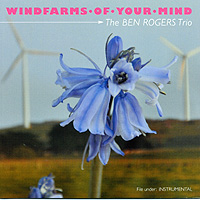 Ben
Rogersóby day surf rock guitar hero, by night, Gypsy Jazz
and swing guitar protagonist, composer and true fretboard artiste.
Compared to Benís 2010 CD, the surf-rocking Instrumentally
Disturbed, by Ben Rogers’ Instrumental Asylum, the
2011 CD release of Windfarms Of Your Mind serves
as an intimate guitar trio affair. Released by The Ben Rogers Trio,
Windfarms finds Ben in the company of his Asylum pals Romana
Geermans (violin) and Nikki Scarlett (bass/ukulele). Ben
cites an early music teacher as the influence behind this return to
his swing music roots with the guitarist adding, ‘This is the
album I’ve wanted to make for a few years now. It’s a collection
of both new and old tunes, the earliest of which is my very first
composition, written as a young student of the guitar in the early
‘60s.' Even so, Ben’s stamp as an original guitarist and
composer is all over the album, to which he confesses, ‘Some
years down the track, I discovered the music of Django Reinhardt,
and this has become a strong influence on my playing and appreciation
of the guitar. For me Django remains an endless source of inspiration.’
The era may evoke the acoustic swing of Django, but the guitar sound
is truly Ben Rogers 2011. There’s an air of musical authenticity
here that cannot be denied. Blending steel guitar and a range of other
guitar sounds, track 5 “National Banjo” is almost an instro
guitar anthem that could work as a folk song as well as a fully fledged,
soaring Hank Marvin-esque production. Anyone who dug Ben’s Instrumental
Asylum, will find much to admire on Windfarms Of Your Mind. Same
as much could be said about track seven, “Laika’s Flight”,
which although ostensibly a long and winding drum-less guitar solo,
is actually a most interesting guitar trek that would also work as
the foundation of a more production laden rock extravaganza. Either
way, the diversity of guitar sounds and styles Windfarms makes
for a most promising first recorded album by the Ben Rogers Trio.
www.BenRogers.com.au
Ben
Rogersóby day surf rock guitar hero, by night, Gypsy Jazz
and swing guitar protagonist, composer and true fretboard artiste.
Compared to Benís 2010 CD, the surf-rocking Instrumentally
Disturbed, by Ben Rogers’ Instrumental Asylum, the
2011 CD release of Windfarms Of Your Mind serves
as an intimate guitar trio affair. Released by The Ben Rogers Trio,
Windfarms finds Ben in the company of his Asylum pals Romana
Geermans (violin) and Nikki Scarlett (bass/ukulele). Ben
cites an early music teacher as the influence behind this return to
his swing music roots with the guitarist adding, ‘This is the
album I’ve wanted to make for a few years now. It’s a collection
of both new and old tunes, the earliest of which is my very first
composition, written as a young student of the guitar in the early
‘60s.' Even so, Ben’s stamp as an original guitarist and
composer is all over the album, to which he confesses, ‘Some
years down the track, I discovered the music of Django Reinhardt,
and this has become a strong influence on my playing and appreciation
of the guitar. For me Django remains an endless source of inspiration.’
The era may evoke the acoustic swing of Django, but the guitar sound
is truly Ben Rogers 2011. There’s an air of musical authenticity
here that cannot be denied. Blending steel guitar and a range of other
guitar sounds, track 5 “National Banjo” is almost an instro
guitar anthem that could work as a folk song as well as a fully fledged,
soaring Hank Marvin-esque production. Anyone who dug Ben’s Instrumental
Asylum, will find much to admire on Windfarms Of Your Mind. Same
as much could be said about track seven, “Laika’s Flight”,
which although ostensibly a long and winding drum-less guitar solo,
is actually a most interesting guitar trek that would also work as
the foundation of a more production laden rock extravaganza. Either
way, the diversity of guitar sounds and styles Windfarms makes
for a most promising first recorded album by the Ben Rogers Trio.
www.BenRogers.com.au
mwe3.com presents an interview with
BEN ROGERS
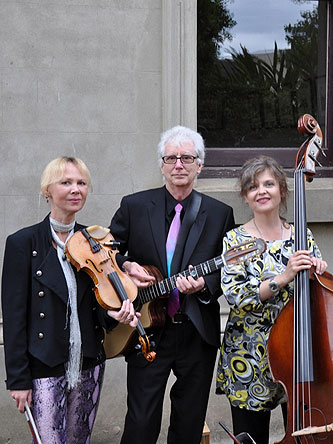 mwe3:
After hearing your new Windfarms Of Your Mind, some fans of
your surf-rock albums with Ben Rogers’ Instrumental Asylum might
think you have a split musical personality. How would you answer to
that and how do you compare your love of surf-rock instrumental music
with your rootsy kind of Gypsy jazz / Americana style on the Windfarms
album? And is there a story as to how you came up with that humorous
CD title?
mwe3:
After hearing your new Windfarms Of Your Mind, some fans of
your surf-rock albums with Ben Rogers’ Instrumental Asylum might
think you have a split musical personality. How would you answer to
that and how do you compare your love of surf-rock instrumental music
with your rootsy kind of Gypsy jazz / Americana style on the Windfarms
album? And is there a story as to how you came up with that humorous
CD title?
BR: Maybe I do have a split musical personality, but I just enjoy
using stringed instruments to make sounds that express different emotions.
Each instrument and band lineup provides a vocabulary appropriate
for certain situations. My two current bands are very different, but
together they provide scope for me to draw on many years of learning,
practicing and playing in various genres and situations.
I love both groups. Instrumental Asylum gives me the opportunity to
play with a solid, well rehearsed rhythm section using an overdriven,
reverb drenched Fender Strat sound, while The Ben Rogers Trio provides
the opportunity to explore a different range of music that is often
more complicated. Some of that repertoire is approached in a more
traditional classical form rather than the improvisational approach
of rock and jazz. However, there is still room for jazz improvisation
on some of the tracks where the guitar/double bass rhythm suits that
style. Some of my compositions are played by both bands with very
different results—for example “Conversations With A Frog”,
on the Windfarms album, is also on Reverb Rehab.
I started out learning guitar in the heyday of guitar instrumentals
when The Shadows, The Ventures, Duane Eddy etc. were making hit records.
From that time it’s been a musical journey through a range of
styles, and it was like  coming
full circle when I got back into the surf-rock thing about six years
ago. My interest has always been in writing new material, in whatever
genre takes my interest at the time.
coming
full circle when I got back into the surf-rock thing about six years
ago. My interest has always been in writing new material, in whatever
genre takes my interest at the time.
The title Windfarms of Your Mind came about when I spent a
few nights near a wind farm in western Victoria a couple of years
ago. In that few days I wrote a couple of instrumentals that seemed
to be influenced by the nearby turbines. One of the tunes had a kind
of cyclical pattern, and it reminded me of the pattern of that 1960s
song Windmills of Your Mind, with its repeating, canon-like
form.
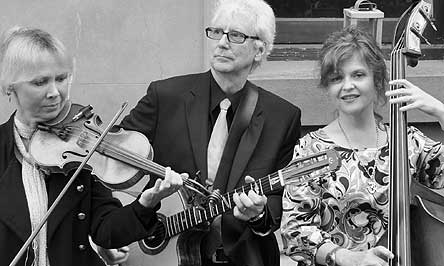 mwe3:
It’s just amazing how many rock and fusion guitarists cite Django
Reinhardt as a big influence. Hank Marvin and John Jorgenson are just
a couple I can think of. Why do you think instrumental rock guitarists
also have such an interest and affinity for Django and the whole Gypsy
Jazz thing? Hank mentioned to me that it’s kind of manly thing
as the Gypsy Jazz guitar is not easy to play.
mwe3:
It’s just amazing how many rock and fusion guitarists cite Django
Reinhardt as a big influence. Hank Marvin and John Jorgenson are just
a couple I can think of. Why do you think instrumental rock guitarists
also have such an interest and affinity for Django and the whole Gypsy
Jazz thing? Hank mentioned to me that it’s kind of manly thing
as the Gypsy Jazz guitar is not easy to play.
BR: I don’t see the “manly thing” connection at all.
To me Django is simply the most innovative and inventive guitarist
I’ve ever heard, and I keep coming back to his music for new
inspiration, regardless of the style I happen to be playing at the
time. I’ve done a couple of surf-rock interpretations of Django
tunes, including his most famous tune “Nuages” (on Welcome
to the Instrumental Asylum), and his last composition, the beautiful
but somewhat obscure “Anouman” (on Instrumentally Disturbed).
The Gypsy jazz style is not easy to play, but it’s a great form
of expression for guitarists who have that ability to improvise over
rapid chord changes, and it’s lots of fun. It’s interesting
how popular the genre has become in 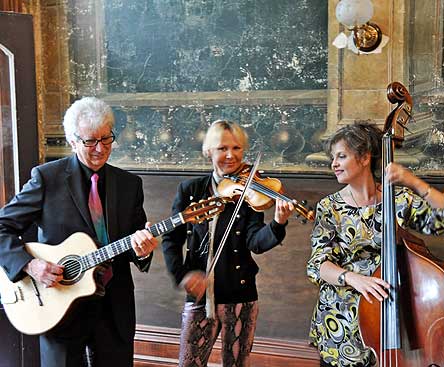 recent
years. In the early 1980s when I first started gigging with what we
called a “hot swing” quartet in Perth (Western Australia),
our band was considered something of a curiosity, as there was only
a handful of bands in Australia playing that genre. Now it’s
almost mainstream, with thousands of YouTube videos, websites dedicated
to Django’s music, mass produced Selmer style guitars readily
available, and Gypsy jazz guitar strings available from major string
manufacturers.
recent
years. In the early 1980s when I first started gigging with what we
called a “hot swing” quartet in Perth (Western Australia),
our band was considered something of a curiosity, as there was only
a handful of bands in Australia playing that genre. Now it’s
almost mainstream, with thousands of YouTube videos, websites dedicated
to Django’s music, mass produced Selmer style guitars readily
available, and Gypsy jazz guitar strings available from major string
manufacturers.
Also I think that Django’s influence on other iconic players
is increasingly being recognized. If you look at a list of guitarists
who cite Django as a major influence it reads like a “who’s
who” of the guitar world—Les Paul, Jimmy Page, Carlos Santana,
Jeff Beck, Eric Clapton to name but a few.
mwe3: What guitars did you play on the Windfarms CD and how
can you compare the Gypsy Jazz guitar itself and the technique involved
in mastering the art form with acoustic guitar and even classical
guitar? Sounds like there was also some electric guitar on Windfarms
but not too much...
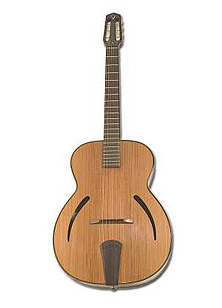 BR:
Most of the acoustic guitar parts were played on an arch-top made
by English luthier John Le Voi—better known for his Selmer style
Gypsy jazz models. I also used a 1938 Gibson L4, and a couple of early
sixties Australian made Maton archtops. The electric guitar parts
were played on a Gibson Johnny A model, through a 1961 Fender Vibrolux.
I used mandolin on a couple of tracks, and Nikki (bass player) played
several rhythm tracks on a resonator ukulele.
BR:
Most of the acoustic guitar parts were played on an arch-top made
by English luthier John Le Voi—better known for his Selmer style
Gypsy jazz models. I also used a 1938 Gibson L4, and a couple of early
sixties Australian made Maton archtops. The electric guitar parts
were played on a Gibson Johnny A model, through a 1961 Fender Vibrolux.
I used mandolin on a couple of tracks, and Nikki (bass player) played
several rhythm tracks on a resonator ukulele.
For the technically inclined, the Gypsy jazz style requires a strong
right hand and the use of a plectrum rather than a finger-picking
style, and the strings are struck closer to the bridge than with other
acoustic styles. This helps to make a treble sound with plenty of
attack that cuts through without amplification.
I don’t feel qualified to comment on mastering the Gypsy Jazz
guitar, as I don’t believe I’ve done that! I am able to
play and write more-or-less in that genre, but there are many virtuoso
players, such as John Jorgenson, who have mastered the technique and
capture the spirit of the style. I don’t try to master any particular
style, but rather just try to develop my own style, incorporating
whatever influences I’ve absorbed over the years. Similarly,
I don’t have an interest in just re-creating the surf-rock sound,
but rather using that genre as a basis for developing our own band
sound.
mwe3: Who plays with you on the Windfarms Of Your Mind album,
why did you select these players and what were some of the challenges
involved in writing the music and working out the arrangements with
the trio on the new CD?
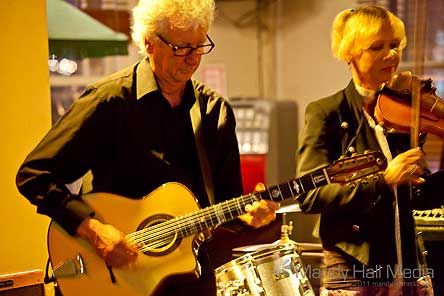 BR:
The bass player is Nikki Scarlett, who plays electric bass with Instrumental
Asylum. On Windfarms she plays double bass and a bit of ukulele.
Nikki is also the main composer of one of the tunes, “Le Viaduc.”
BR:
The bass player is Nikki Scarlett, who plays electric bass with Instrumental
Asylum. On Windfarms she plays double bass and a bit of ukulele.
Nikki is also the main composer of one of the tunes, “Le Viaduc.”
Romana Geermans is our violinist, and she is one of those rare musicians
classically trained violinist with perfect pitch and the ability to
improvise in the Stephane Grappelli style. I composed a lot of the
material with Romana’s playing in mind, and it’s relatively
easy for the three of us to work together, I usually write out the
main melody, Romana memorizes it quite quickly, and then we all play
around with improvised sections. Nikki usually works out her own bass
lines, and we all play around with arrangements.
mwe3: Two of my favorite tracks on the Windfarms CD are “National
Banjo” and “Laika’s Flight”, the latter of which
almost sounds like a John Lennon melody! Can you say something about
those two tracks and what are some of your personal favorite tracks
from the Windfarms CD and what tracks are turning out to be
the most popular from the new Windfarms CD among your fans?
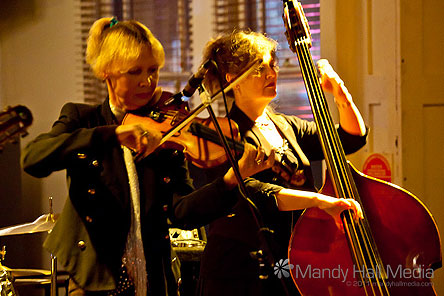 BR:
“National Banjo” just developed from messing around with
my old banjo and a National tri-cone square neck guitar that I have
on extended loan from a friend. I came up with three basic parts,
and then added acoustic guitar and mandolin to build up some sections.
The tune does work without the layering though. I have played it live
as a duet with our violinist Romana.
BR:
“National Banjo” just developed from messing around with
my old banjo and a National tri-cone square neck guitar that I have
on extended loan from a friend. I came up with three basic parts,
and then added acoustic guitar and mandolin to build up some sections.
The tune does work without the layering though. I have played it live
as a duet with our violinist Romana.
“Laika’s Flight” is a bit more complicated. I’m
not sure how I came up with it, but I’m flattered to hear it
compared to a John Lennon melody! I wrote it with the intention of
it being a violin melody, but then found it worked better as an electric
guitar tune. The plaintive melody seemed in keeping with the plight
of Laika, the first dog in space, hence the name.
Although we’re selling Windfarms at our gigs and have
made it available in the US from CD
Baby, we haven’t really done an official release at this
stage, so there hasn’t been a lot of feedback yet.
 I
think that instrumental music often provokes very different responses
from different people. With songs you’re telling them a story
but with an instrumental you are providing the soundtrack for their
own story, and everyone’s will be different. We have had very
positive responses from the limited number of people who have heard
Windfarms so far.
I
think that instrumental music often provokes very different responses
from different people. With songs you’re telling them a story
but with an instrumental you are providing the soundtrack for their
own story, and everyone’s will be different. We have had very
positive responses from the limited number of people who have heard
Windfarms so far.
mwe3: What are your plans moving forward with the Ben Rogers Trio
and the Ben Rogers Instrumental Asylum as we move into 2012?
BR: I don’t have clearly defined goals as far as commercial success
is concerned. My main interest is writing, recording and having the
opportunity to play new music to live audiences. I love to play to
live audiences, whether  the
venue is an inner city pub, a music festival, a café or even
a private house. My main driving force is making the music itself.
The fact that people enjoy listening to it is an added bonus! There’s
such a lot of great music in the world, it’s hard to know the
best way to take our music forward. We are fortunate in Melbourne
with a vibrant live music scene that provides outlets for most styles,
and with great independent music stations (3PBSFM and 3RRR) that support
local music and reach a listening audience open to new music. Who
knows what 2012 will bring?
the
venue is an inner city pub, a music festival, a café or even
a private house. My main driving force is making the music itself.
The fact that people enjoy listening to it is an added bonus! There’s
such a lot of great music in the world, it’s hard to know the
best way to take our music forward. We are fortunate in Melbourne
with a vibrant live music scene that provides outlets for most styles,
and with great independent music stations (3PBSFM and 3RRR) that support
local music and reach a listening audience open to new music. Who
knows what 2012 will bring?
Thanks to Ben Rogers @ www.BenRogers.com.au



